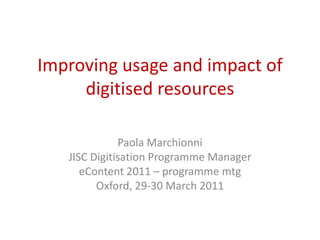Improving Usage of Digitised Resources
•Transferir como PPTX, PDF•
0 gostou•247 visualizações
A presentation from the JISC Programme Meeting for its Content Programme for 2011 http://www.jisc.ac.uk/whatwedo/programmes/digitisation/econtent11.aspx
Denunciar
Compartilhar
Denunciar
Compartilhar

Recomendados
Mais conteúdo relacionado
Mais procurados
Mais procurados (19)
15.06.05 Using web and social media metrics to measure success and drive digi...

15.06.05 Using web and social media metrics to measure success and drive digi...
Transforming assessment and feedback with technology - Jisc Digifest 2016

Transforming assessment and feedback with technology - Jisc Digifest 2016
49 a case study in the design of educational widgets

49 a case study in the design of educational widgets
QA in e-Learning and Open Educational Resources (OER)

QA in e-Learning and Open Educational Resources (OER)
A digital literacies framework – its strengths, weaknesses and opportunities

A digital literacies framework – its strengths, weaknesses and opportunities
A Challenge to Web Accessibility Metrics and Guidelines: Putting People and P...

A Challenge to Web Accessibility Metrics and Guidelines: Putting People and P...
ReOPEN project presentation with the focus on dissemiantion, sustainability a...

ReOPEN project presentation with the focus on dissemiantion, sustainability a...
Leveraging change through digital capability - Lawrie Phipps, Terri Smith and...

Leveraging change through digital capability - Lawrie Phipps, Terri Smith and...
Semelhante a Improving Usage of Digitised Resources
Semelhante a Improving Usage of Digitised Resources (20)
One Standard to rule them all?: Descriptive Choices for Open Education

One Standard to rule them all?: Descriptive Choices for Open Education
7Cs of Learning Design: How it really happens - UNISA Benchmark Workshop

7Cs of Learning Design: How it really happens - UNISA Benchmark Workshop
Collaborative Learning Object Exchange (CLOE): A Case Study

Collaborative Learning Object Exchange (CLOE): A Case Study
Building a 21st Century Digital Student Experience

Building a 21st Century Digital Student Experience
Approaches to supporting Open Educational Resource projects

Approaches to supporting Open Educational Resource projects
Mais de Alastair Dunning
Mais de Alastair Dunning (20)
Winning the Tour de France, Research Data and Data Stewardship

Winning the Tour de France, Research Data and Data Stewardship
Summary of the Programme Meeting by Catherine Grout

Summary of the Programme Meeting by Catherine Grout
How JISC Projects are Funded and Sustained (2010 version)

How JISC Projects are Funded and Sustained (2010 version)
Improving Usage of Digitised Resources
- 1. Improving usage and impact of digitised resources Paola Marchionni JISC Digitisation Programme Manager eContent 2011 – programme mtg Oxford, 29-30 March 2011
- 3. Toolkit for the Impact of Digitised Scholarly Resources (TIDSR)
- 4. http://microsites.oii.ox.ac.uk/tidsr/ - to be updated May 2011
- 5. Digital Impacts: how to measure and understand the use and impact of digital content
- 7. not (just) about metrics, usability or Search Engine Optimisation
- 8. issues relating to different stages in the development of a digital resource, life cycle approach
- 9. some highlights here – not a comprehensive or exhaustive list
- 10. some high level issues and nitty gritty details
- 11. some common patterns
- 12. some solutions
- 14. plan on measuring impact from the beginning of a project, to integrate impact measures in the design
- 15. monitor impact regularly, but don’t become bogged down by it
- 17. task somebody in the team with this responsibility
- 18. specific workpackage that branches off into all other activities
- 20. developed as part of Marketing and Comms strategy
- 22. and from other platforms
- 26. but collection still not well integrated into catalogue searches
- 28. project name (CEDAR), project blog (East London Theatre…) and final project web site (OTHA) all different
- 32. be quick and easy
- 33. reflect users’ working practices
- 39. data sets relevant to researchers but not many researchers use the site
- 41. open content to collections will increase impact
- 43. Institute of Historical Research: difficulty in getting resources listed by libraries until they introduced an element of subscription content
- 44. perception of “value” of a resource if there is a charge/user has to pay for it?
- 46. If you plan to measure how much your resource in being talked about in blogs, make sure you do promote your website through blogs in the first place
- 48. Identify a “champion” at the end of the project who will make sure the resource is looked after and sustained
Notas do Editor
- Consideration to take into account when licencing material, in relation laso to copyright, sustainability and funding
